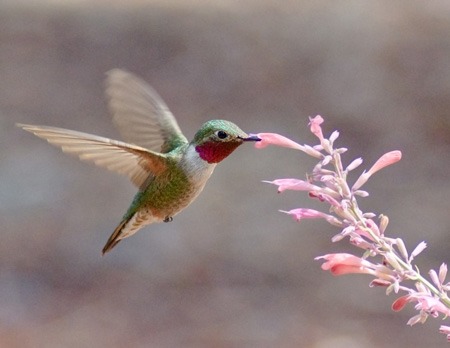August in the Salvia Garden
First posted on Jul 29, 2017

August is a time when many sages grow rapidly and feed a frenzy of pollinators in need of rich nectar and pollen. It's hot, so you have to be careful not to let plants or yourself wilt.
Here are some tips for tending your garden this month:
- Easy does it. Work in your garden early and late in the day to avoid heat stress. Drink lots of water to stay hydrated.
- Water, water, water! If it is hot and dry where you live, plants may need more than one watering a day. This is especially true for container plants. Keep soil moist but not soggy. Also, now is a good time to set up some rain barrels to make good on your resolution to use graywater. For information about waterwise gardening, please check the Xeric Choices section of our Everything Salvias Blog. Also, here are container watering basics.
- Keep birdbaths full. Tiny garden residents also need water. For bees, place small, shallow bowls of pebbles and water on the ground. Keep birdbaths full for songbirds. Hummingbirds, however, have feet that are too tiny to access birdbaths. So, periodically spray water on shrubs near your gardens. Hummers will take a bath by rustling their feathers against damp foliage. Finally, make small puddles for butterflies to splash in and consume the mineral matter they need. Fill shallow pie pans with sand, soil, a bit of fertilizer, and water.
- Plant with care. August is still a good time for planting perennials that tolerate heat. This is especially true if you live where late autumn and winter are moderate and grow late blooming sages. Heat-tolerant examples include Envy Hybrid Sage (Salvia x Envy 'Elk'), Grape Scented Sage (Salvia melissodora), and Shaggy Chiapas Sage (Salvia eizi-matudae). Protect all new plantings from harsh sun exposure by covering them with a piece of shade cloth or newsprint. Conserve moisture with mulch. Gravel is better than bark for Salvias, because it doesn't mold.
- Go easy on fertilizer. Some Salvias love rich, well-fertilized soils, but others prefer it lean. Container plantings need a weak dose of slow-release fertilizer about every two months due to nutrients diminishing over time. Fertilizing may also be necessary If you live where it rains a lot, because excess water may severely leach nutrients away from roots. Read our Guide to Understanding & Using Fertilizer for more information.
- Attack spider mites with a hose. They thrive during hot, dry weather and take advantage of heat-stressed plants. Get out the garden hose for a heavy spray of water to wash away spider mites and remove the fine filament they spin from one plant to another. Here's more information.
- Trim plants to ease crowding. Infestations of pests may spread rapidly when Salvias are crowded. Trimming also is a good solution for correcting leggy growth and encourages second bloom.
- Prepare cold frames for late fall use. A cold frame helps in overwintering plants that can take some chill, such as herbs. If you want to produce fresh culinary sage and other herbs during winter, a cold frame may work well. Here is a helpful video about using a cold frame.
- Observe and Plan. Take breaks to walk around your yard and ponder what is doing well and what can be improved. It's peaceful and helpful to sit near a garden and observe, because It allows you to think about color, composition, holes in the landscape, overcrowding, and pollinator needs.
Need More Advice?
Always feel free to call or write us at Flowers by the Sea Farm and Online Nursery. We're glad to help answer your questions about growing Salvias.
Edited Aug 3, 2023 05:00 PM
Alicia Rudnicki for FBTS
Plants mentioned in this article

 Salvia SALLYFUN™ Blue Lagoon
Salvia SALLYFUN™ Blue Lagoon  Salvia transsylvanica
Salvia transsylvanica  Salvia COOL Periwinkle
Salvia COOL Periwinkle  Salvia BODACIOUS 'Rhythm and Blues'
Salvia BODACIOUS 'Rhythm and Blues'
1 Comments
My Chantilly Laces are gorgeous with sea shell cosmos.
Ali D